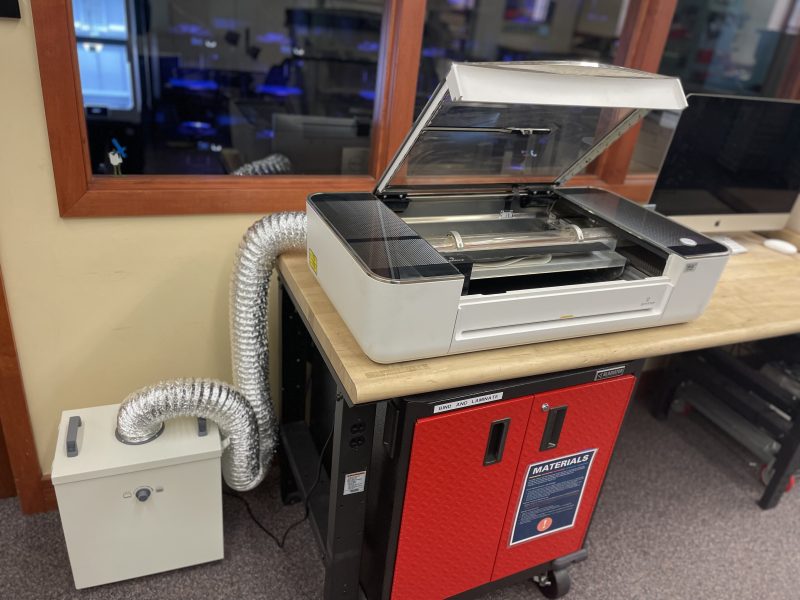Glowforge Station (MakerLab)
Our Glowforge Station features a Glowforge Pro laser cutter, a machine which uses a beam of light to cut and engrave on a variety of materials including wood, acrylic, leather, and more. To learn more about laser cutting, visit our training guide.

-
How do I use the Glowforge Station? Tab Open
-
Using the Glowforge Safely Tab Closed
-
Use only Approved Materials Tab Closed
How do I use the Glowforge Station? Accordion Open
Take our Glowforge training (required)
- The Glowforge laser cutting station is located in MakerLab on the first floor of the Cline Library. The Glowforge Station is meant for laser cutting and engraving projects only.
- For safety purposes, all users must first take our online training guide.
- Once you have completed the training guide, take the safety quiz and keep a copy of your successful completion code to make your booking.
- Reserve the station online.
- You must supply your own Glowforge Proofgrade materials or purchase some at the Ask Us! Desk; use of off-brand material is prohibited except with written approval.
Using the Glowforge Safely Accordion Closed
Improperly operating the Glowforge unit can cause fire, eye or skin injury from laser exposure, or exposure to chemicals that may be health hazards. These can result in serious injury or even death. Because of this, please follow these safety instructions:
- In the event of any emergency or malfunction, unplug the power cord on the back of the unit.
- Always turn on the air filter before use. To prevent smoke and fumes from escaping the unit, do not open the lid until the fans stop.
- There may be some odor present while printing. However, if you detect a strong, sharp smell that also causes eyes, nose, or throat irritation, or if there is visible smoke escaping while the lid is closed, stop immediately and re-check the air filter and connected hose.
- Never leave the Glowforge unit unattended while operating – either when it’s paused and ready to print (with the button flashing) or while it’s actually printing (with the button on). Always stay within sight and look inside frequently; any damage will be your responsibility.
- Do not put anything inside the Glowforge that is not laser compatible. Only use the approved materials listed below (see next section).
- Do not touch the head or arm of the Glowforge while it is powered on. If you do so, turn it off, then back on again to prevent damage.
- Do not stack materials; for example attempting to cut two or more sheets of material at a time. Multiple sheets are more likely to burn.
- Do not leave anything on, or around the Glowforge. This is especially true of objects or flammable liquids that may catch fire.
- Always allow prints to cool for a few minutes before handling them. Many materials may remain hot for a few minutes after cutting.
- A small, candle-like flame where the laser beam strikes the material is normal. This flame should move with the laser and should not remain lit when the laser has moved past.
Use only Approved Materials Accordion Closed
For safety reasons, the Glowforge Laser Cutter can only cut and engrave materials approved by the manufacturer. In addition, these materials must be CO2 laser compatible. You can view and verify available materials by visiting glowforge.com/materials or Inventables.com.
- Draftboard (Size: 12″ x 20″; Thickness: Approx 1/8″) — $10
- Clear Acrylic (Size: 12″ x 20″; Thickness: Approx 1/8″) — $20
- Hardwood* (Size: 6″ x 12″; Thickness: Approx 1/8″) — $20
Please note:
Not all materials will work in the Glowforge:
- If you aren’t completely sure that your material is laser-compatible, do not put it in the Glowforge unit.
- Some materials look similar to laser-compatible materials, but are different. For example, vinyl can be mistaken for some laser-compatible materials but emits harmful smoke and fumes.
- Materials may have contaminants, coatings, or additives that are not laser-compatible. For example, certain plywood glues, inks, adhesives, dyes, and paints may not be laser-compatible.
- Some materials can reflect the laser and damage the Glowforge unit. For example, copper and chrome can reflect the infrared laser light.
Materials must be an appropriate size:
- Materials that do not fit properly may obstruct operation and result in damage and increased risk of fire. Materials must be no more than 21 in (53.3 c m) wide and must not be so long as to touch the end of the Glowforge unit. Material must be less than ½ in (1.2 c m) tall if the crumb tray is in, or less than 2 in (5.0 c m) tall if it is removed.
Materials must remain flat:
- Materials must be flat so they rest on the crumb tray.
- Material must never double back on itself, for example curling up.
- Do not place rolled-up material in the Glowforge. It may be too tall, or unroll during printing, obstructing operation.
- While a bulge is acceptable, for example from warped wood, the highest point of the material may not extend more than ½ in (1.2 c m).
- Should material curl or bend so it reaches more than ½ in (1.2 c m) during a print, turn off the power immediately.
